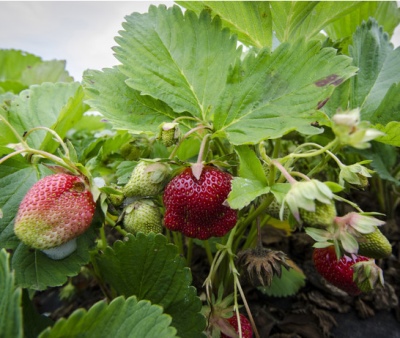
- Authors: Denmark
- Taste: pleasant, dessert, sweet with sourness
- The size: large
- Weight: 40-60 gr
- Yield rate: high
- Yield: up to 1 kg per bush
- Ripening terms: early
- Appointment: fresh consumption, processing (juice, jam, jam, etc.)
- Berry color: bright red
- Winter hardiness: winter hardy, up to -35 С
Strawberry Marshmallow is a very popular variety in Europe, and in recent years it has begun to actively spread throughout Russia. Strawberry gardeners tend to choose varieties with large, sweet fruits and high yields. Strawberry Marshmallow meets these requirements.
Breeding history
There is no official information on the origin of this variety. It is not included in the Russian State Register of Breeding Achievements Permitted for Use, and has not been tested on the territory of our country. However, its seedlings and seeds are sold by many nurseries and agricultural firms in Russia.
Description of the variety
The Zephyr variety first appeared in Denmark, after which it spread to Norway and other European countries. Successful cultivation proves the variety's ability to produce a good harvest in rather difficult climatic conditions.
Strawberry Marshmallow is a very early variety with large berries. The pubescent leaves grow on compact bushes, the height of which reaches 40-60 centimeters. Slightly corrugated dark green leaf plates are located on erect stems up to 10 centimeters long. Peduncles are directed upwards, each of them bears approximately 15-20 buds. Peduncles are strong, do not bend under the weight of the berries to the ground.
Ripening terms
In greenhouse conditions, the berries ripen in early May, in open beds, ripening occurs 2 weeks later. Earlier maturation is possible under the right conditions
Growing regions
Bushes of the Zephyr variety are not too demanding on natural and climatic conditions. Therefore, they can be successfully grown throughout the entire European territory, as well as in Russia.
Yield
Zephyr is a high-yielding variety. Strawberries begin to bear fruit from the first year. From one bush, you can get up to 1 kilogram of ripe berries.
Berries and their taste
The berries are large, bright red in color, with a glossy surface, their average weight is about 20 g, but berries of 40-60 g are often found in shape, wide, rounded, some may be ribbed. Taste with a subtle sourness, pleasantly sweet, dessert. The flesh of berries without voids, deep pink color with light veins and a pronounced aroma. The berries look great and retain their great appearance during transport.
This variety is characterized by the one-dimensionality of ripening fruits, that is, even at the end of the season, the berries retain their large size and do not become smaller.
Growing features
The following types of soil are preferred: sand, clay, black soil. When planting, the distance between the bushes should be at least 25 centimeters. If the bush is not compact enough, then it is better to keep a distance of 50 centimeters or more. When planting on seedlings, there should be a bundle rhizome and more than three well-developed leaves. After planting, it is necessary to ensure sufficient watering of the beds and mulching with straw.




Site selection and soil preparation
The Zephyr variety is preferable to plant on flat areas where the soil has neutral acidity. It is good if any types of cabbage, as well as onions and beets, were previously planted on this site.

Pollination
Brush pollination is an easy way to ensure yields. To do this, you need to draw a brush over the colors at the right time.
There is an option for pollination in the greenhouse. This requires double-sided pollination with open windows. This method is not suitable for greenhouses.
Top dressing
Before planting the bushes, compost or humus must be added to the soil. The amount is calculated from the ratio of 5 kg of top dressing per 1 square meter. Thanks to this, the soil is enriched with the necessary useful elements, and its air permeability is also improved.

One of the important techniques in strawberry care is feeding. Regular fertilization guarantees a rich harvest. There are several different ways to feed strawberries, and each of them is designed for a specific period of plant development. During flowering, fruiting and after it, feeding should be different.
Frost resistance and the need for shelter
If there is a sufficient layer of snow on top of strawberry beds, the Zephyr variety outdoors can withstand temperatures as low as -35 degrees Celsius. In case of insufficient snow cover, the roots of the bush die at a temperature of -8 degrees, the rosette above the ground can withstand frosts down to -10 degrees Celsius.

Diseases and pests
Strawberry Marshmallow is highly resistant to various diseases. Strawberry bushes are not susceptible to fusarium disease, powdery mildew, rot, brown and white spots. However, they are susceptible to damage by strawberry mites.

Strawberries are often subject to many dangerous diseases that can seriously undermine their condition. Among the most common are powdery mildew, gray mold, brown spot, anthracnose, and verticillosis.Before buying a variety, you need to inquire about its disease resistance.
Reproduction
Reproduction takes place with the help of whiskers, which are formed in large numbers. It is thanks to the presence of the mustache that it is possible to actively cultivate this variety.
Some gardeners successfully propagate strawberry marshmallows using seeds, but this method has not found widespread use.

Review overview
Gardeners note the unpretentiousness of the variety even under not very favorable natural conditions and rejoice in the abundant harvest.
Excellent transportability is a pleasant addition to the palatability. The berries do not crumple, do not flow, retain their shape.
For personal use, strawberry Marshmallow is a great option - large and sweet.
A high yield of strawberries Marshmallow can be obtained both in greenhouse conditions and in open beds. It can be grown for personal or commercial purposes.


















































































